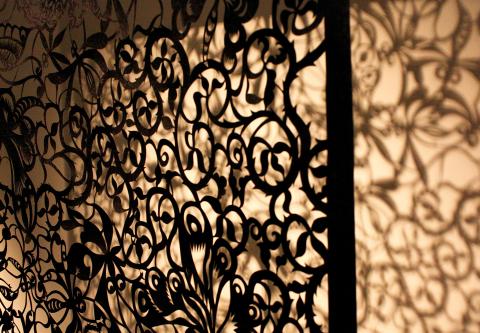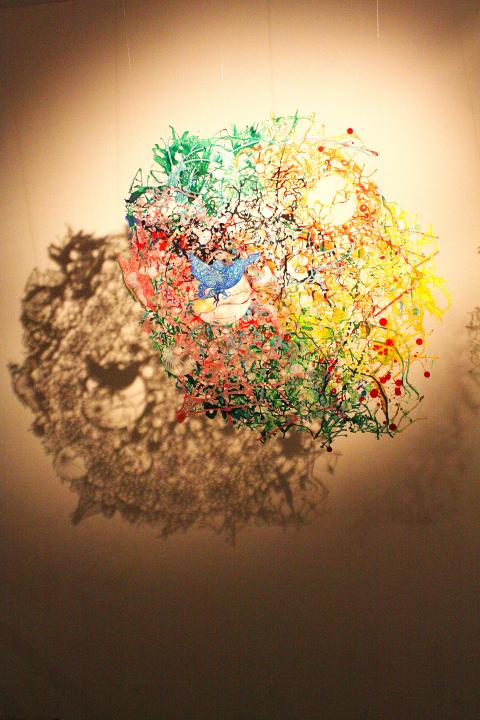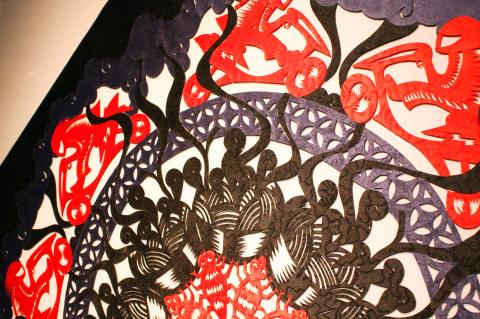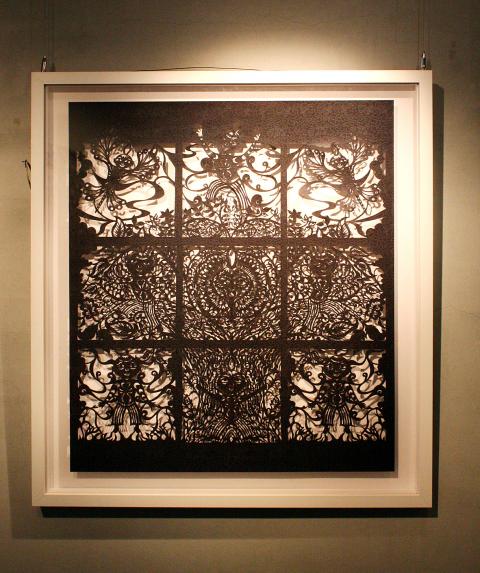Tim Budden’s papercuttings tell stories with shadows and light. The Wales-born artist’s spellbindingly intricate artwork is on display at the Suho Memorial Paper Museum (樹火紀念紙博物館) until March 24.
Before moving to Taiwan, Budden was a sculptor who created puppets and set pieces for theatrical performances. He also drew a critically acclaimed comic strip about a group of badgers living unhappily alongside humans.
After arriving in this country, Budden says he was uninterested in traditional Chinese art forms until he stumbled upon a book about papercuts created by retired women in China. He was struck by the similarity between the papercuts and the black-and-white line art he had used in his comic strips.

Photo courtesy of Suho Memorial Paper Museum
“They used papercuts to tell the story of their lives,” says Budden. “They were like cartoons, but 3D. You can touch them and hold them.”
Like his comic strip, many of Budden’s papercuts deal with the sometimes uneasy relationship between a place and its inhabitants. While his comics were about conflicts between badgers and the humans who threatened their safety, Budden’s papercut artwork offers a foreigner’s perspective on life in Taiwan. Many revolve around the adventures of a small child named Daniel, who is a composite of Budden and his young son.
“I’m not from Taiwan and I’m trying to understand this culture. I feel like a child, trying to understand more: ‘Why are they doing this, what is this for?’” says Budden.

Photo courtesy of Suho Memorial Paper Museum
Motifs seen in Budden’s complex, lacelike artwork include butterflies, steam wafting from hot bowls of beef noodle soup and cockroaches.
One work shows moped riders being swept away by torrents of water during a typhoon. Budden was struck by drivers who continue to speed recklessly even after roads have flooded and television news segments in which reporters put their safety at peril to venture into hazardous conditions and tell viewers the obvious (“It’s raining!”). Another papercut recounts the time Budden and his friend were forced to climb a tree to escape an angry wild boar after getting lost while hiking in Jinguashih (金瓜石).
Most of Budden’s papercuts are created from red or black paper backed with silk and have to be carefully planned in advance so the delicate designs will not tear or warp once they are completed and hung. One work, Butterfly Blast!, which features so many of the winged creatures that Budden has lost count, took six weeks to design and about 10 to 12 days to cut.

Photo courtesy of Suho Memorial Paper Museum
Budden is now experimenting with a more freeform technique inspired by colorful beach rocks and leaf skeletons he found during a trip to Hualian. He begins by spilling acrylic paint on paper and blowing on it through a straw so the colors run together.
“When it dries, you get these fantastic patterns,” says Budden. The random shapes and lines inspire the different shapes Budden cuts into the paper. On first glance, it is hard to discern what each individual detail is supposed to depict. When the papercuts are hung up and a light shone through them, however, the artwork casts strong, defined lines against the wall, allowing viewers to pick out butterflies and 24 different kinds of beetles.
“You can see one image when you look at papercutting and something completely different behind it,” says Budden. “Shadows for me are full of secrets.

Photo courtesy of Suho Memorial Paper Museum
ets.”

In Taiwan there are two economies: the shiny high tech export economy epitomized by Taiwan Semiconductor Manufacturing Co (TSMC, 台積電) and its outsized effect on global supply chains, and the domestic economy, driven by construction and powered by flows of gravel, sand and government contracts. The latter supports the former: we can have an economy without TSMC, but we can’t have one without construction. The labor shortage has heavily impacted public construction in Taiwan. For example, the first phase of the MRT Wanda Line in Taipei, originally slated for next year, has been pushed back to 2027. The government

July 22 to July 28 The Love River’s (愛河) four-decade run as the host of Kaohsiung’s annual dragon boat races came to an abrupt end in 1971 — the once pristine waterway had become too polluted. The 1970 event was infamous for the putrid stench permeating the air, exacerbated by contestants splashing water and sludge onto the shore and even the onlookers. The relocation of the festivities officially marked the “death” of the river, whose condition had rapidly deteriorated during the previous decade. The myriad factories upstream were only partly to blame; as Kaohsiung’s population boomed in the 1960s, all household

Allegations of corruption against three heavyweight politicians from the three major parties are big in the news now. On Wednesday, prosecutors indicted Hsinchu County Commissioner Yang Wen-ke (楊文科) of the Chinese Nationalist Party (KMT), a judgment is expected this week in the case involving Hsinchu Mayor Ann Kao (高虹安) of the Taiwan People’s Party (TPP) and former deputy premier and Taoyuan Mayor Cheng Wen-tsan (鄭文燦) of the Democratic Progressive Party (DPP) is being held incommunicado in prison. Unlike the other two cases, Cheng’s case has generated considerable speculation, rumors, suspicions and conspiracy theories from both the pan-blue and pan-green camps.

Stepping inside Waley Art (水谷藝術) in Taipei’s historic Wanhua District (萬華區) one leaves the motorcycle growl and air-conditioner purr of the street and enters a very different sonic realm. Speakers hiss, machines whir and objects chime from all five floors of the shophouse-turned- contemporary art gallery (including the basement). “It’s a bit of a metaphor, the stacking of gallery floors is like the layering of sounds,” observes Australian conceptual artist Samuel Beilby, whose audio installation HZ & Machinic Paragenesis occupies the ground floor of the gallery space. He’s not wrong. Put ‘em in a Box (我們把它都裝在一個盒子裡), which runs until Aug. 18, invites